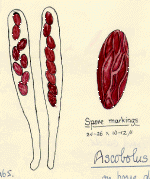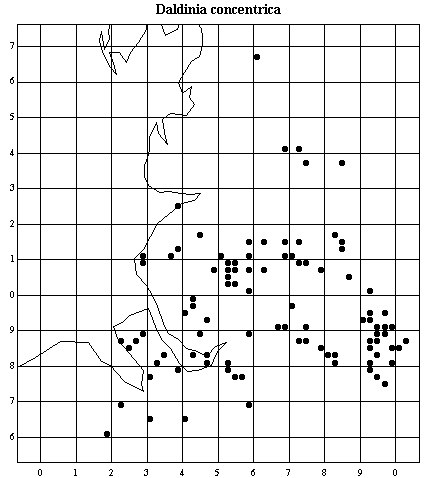North West Fungus Group goes on-line
by
Paul F Hamlyn & Rita Cook
(This article originally appeared in Mycologist, 1996, 10(4), 177-179.)
The Internet and its most popular manifestation, the World Wide Web (Web or WWW for short), is a global information resource that is growing exponentially. Many societies are now represented on the Internet. Creating Web pages is a cheap and efficient way of publicising information, keeping people updated about activities and it also provides an easy way to get their feedback via e-mail. The North West Fungus Group (NWFG) is the first amateur fungus recording group in the UK to go on-line. By including links to related sites such as the British Mycological Society (BMS) home page, the Web can be used to promote the mycological community as a whole. This article includes a brief history about the activities of amateur mycologists in the Northwest of England and events leading to the formation of the NWFG cumulating in the setting up of a Web site.
History
The Group was first set up as the Mycology Section of the North Western Naturalists Union (NWNU) by Dr Hincks of the Manchester Museum in the mid-1940s. At this stage it was an informal gathering of a mere half dozen or so enthusiasts including professional botanists and keen amateurs.
Minutes and records do not appear until a decade later. Minutes of the AGM held in 1956 reveal that the group remained small and that availability of public transport dictated the choice of venue for forays. The few records listed are included only as a part of the minutes of the AGM. Only names of fungi without habitat details etc were noted, except in the case of a few debatable finds. This format persisted for a further 15 years.
 Miss E. Harthan our oldest member, now in her 92nd year and the sole survivor of the original group, became Section Secretary in 1956 and remained in post for 25 years. Her history encapsulates that of the Group and the early work done by amateurs generally. The serious detailed recording she undertook personally from 1941 onwards is contained in 20 notebooks comprising careful notes and paintings of her finds which remain with us today. Her library reflects the advances made over the years in the literature available to amateurs. The early authorities - Massee, Swanton, Carleton Rea and Lister - are included as are the later Wakefield and Dennis literature and the Leeds University ‘Naturalist’ keys (1950s). In those early days much more material was forwarded to Kew for identification or confirmation by, for example, Dr Derek Reid or Miss Elsie Wakefield and several firsts attributable to Miss Harthan are described in the Transactions of the British Mycological Society (1952; 1958).
Miss E. Harthan our oldest member, now in her 92nd year and the sole survivor of the original group, became Section Secretary in 1956 and remained in post for 25 years. Her history encapsulates that of the Group and the early work done by amateurs generally. The serious detailed recording she undertook personally from 1941 onwards is contained in 20 notebooks comprising careful notes and paintings of her finds which remain with us today. Her library reflects the advances made over the years in the literature available to amateurs. The early authorities - Massee, Swanton, Carleton Rea and Lister - are included as are the later Wakefield and Dennis literature and the Leeds University ‘Naturalist’ keys (1950s). In those early days much more material was forwarded to Kew for identification or confirmation by, for example, Dr Derek Reid or Miss Elsie Wakefield and several firsts attributable to Miss Harthan are described in the Transactions of the British Mycological Society (1952; 1958).
The group changed little until, in 1975, Dr George Taylor of the Botany Department of Manchester University became Chairman, bringing with him student members. Dr Taylor offered professional expertise and a more structured approach to recording, though annual lists still included only species names. The first popular field guide, Collins Guide, had appeared in 1963 and remained an encouraging landmark for beginners. In addition Dr Taylor now organised several weekend courses at Manchester University including that led by Dr Roy Watling who inspired many beginners to take up the more serious study of mycology. These developments elicited a steady increase in Section membership. Dr Taylor remained as Chairman until 1982 and continued to be involved as Section Recorder until his early death in 1985.
In 1984 Rita Cook became Chairman. The group continued to function without change for a further five years during which period however more popular field guides appeared - Phillips, Bon and the more serious work of Moser. Then from 1989 onwards several events conspired to produce major changes in the mycological scene, both nationally and locally.
For example, at national level there was an enormous expansion of public curiosity about ‘mushrooms and toadstools’ inspired by the media. Then, more specifically, the British Mycological Society (BMS) urged its members to forward records of 50 selected species in order to investigate their status through the medium of mapping. This initiative inspired the NWNU Mycology Section to set up its own Common Fungi Survey as a contribution to the national effort and more particularly to encourage amateurs of all grades, both members and non-members, to ‘record with purpose’. As a result of both these factors, numbers attending autumn forays more than doubled and the Section suddenly found itself presented with a wide range of people whose demands for knowledge and training were not being met.
At national level the BMS was experiencing a similar problem. Complaints were made that it was not adequately meeting the needs of their Associate Members who were largely, though not solely, amateurs. The Society responded by appointing a National Associates’ Co-ordinator with a brief to appoint regional organisers to promote improved provision for the beginner and amateur. At local level, the Mycology Section of the NWNU felt it needed to examine its status and resources. An important consideration was that, with the advent of the Common Fungi Survey, the Botany Department of the Liverpool Museum had become the focus for many of its activities. This situation arose when, in exchange for help from Rita Cook in setting up a regional mycological database, they offered professional advice and very generous administrative support for the group’s recording and mapping initiatives. In addition the Museum could provide resources for other educational projects. The parent body, the NWNU, with its very limited funding could not offer such support, and, sadly for its long association with the Section, many newcomers to mycology were now expressing a wish to join a specialist group rather than a general natural history organisation. For these reasons the Section decided that it must now become an autonomous, self-funding, Regional Group with closer ties with the BMS (Rita Cook was by now Regional Organiser for the Northwest) in addition to its close working relationship with the Liverpool Museum. However, happily, it retained its links with the NWNU by becoming an Affiliated Society.
The change in status took place at an Inaugural General Meeting in 1994 when, after half a century, the former Mycology Section of the NWNU became the independent North West Fungus Group (NWFG). Today it stands as a flourishing regional body with a much increased membership, its own twice-yearly Newsletter, and an increased range of activities to meet not only the varying needs of its members but also to satisfy the increasingly wider interested public whose help it must enlist for the support of current conservation initiatives. Not least, it has established close links with other regional groups.

NWFG Web Site
To publicise the work of the NWFG a Web site was set up in June this year. Web pages are written in HTML (HyperText Mark-up Language) which is relatively easy to learn as explained in a forthcoming article ‘Creating a mycological site on the Internet’. Each page has a unique address or URL (Uniform Resource Locator) which allows it to be easily found using an Internet connection and a Web browser.
A home page usually contains links to sub-pages which may have further links, and the whole collection of pages is known as a Web site. Thus, a well designed home page is both the introduction and index to the rest of the site. The NWFG Web site includes articles from the group's newsletter and from members, a fungus facts section, images of fungi, links to other mycological sites and a selection of dot distribution maps (see picture) from the Common Fungi Survey carried out in the Northwest of England and Wales. A simple feedback form enables anyone to request notification by e-mail when the site has been updated and a counter monitors how many times the home page has been visited. We hope to include scanned drawings and paintings of fungi by Miss E. Harthan in the near future.
Acknowledgements
The authors are grateful to Mike Palmer, Mike Walton and other members of the NWFG for their help and encouragement. We also thank John Edmondson, curator of botany at Liverpool Museum, for providing computer facilities to produce the Common Fungi Survey dot distribution maps.
References
Wakefield, E.M. (1952) New or rare British Hymenomycetes (Aphyllophorales). Transactions of the British Mycological Society 35: 34 - 65.
Pearson, A.A. (1952) New records and observations. V. Transactions of the British Mycological Society 35: 97 - 122.
Reid, D.A. (1958) New or interesting records of British Hymenomyces. II. Transactions of the British Mycological Society 41: 419 - 445.
Copyright Note
The authors thank Dr Geoff Hadley, Senior Editor of the Mycologist, for granting permission to republish this article on-line. Mycologist is a quarterly journal, published for the British Mycological Society by Cambridge University Press.
Copyright © 1996 Mycologist
Return to North West Fungus Group
This Page URL = http://fungus.org.uk/nwfg/history.htm
 Miss E. Harthan our oldest member, now in her 92nd year and the sole survivor of the original group, became Section Secretary in 1956 and remained in post for 25 years. Her history encapsulates that of the Group and the early work done by amateurs generally. The serious detailed recording she undertook personally from 1941 onwards is contained in 20 notebooks comprising careful notes and paintings of her finds which remain with us today. Her library reflects the advances made over the years in the literature available to amateurs. The early authorities - Massee, Swanton, Carleton Rea and Lister - are included as are the later Wakefield and Dennis literature and the Leeds University ‘Naturalist’ keys (1950s). In those early days much more material was forwarded to Kew for identification or confirmation by, for example, Dr Derek Reid or Miss Elsie Wakefield and several firsts attributable to Miss Harthan are described in the Transactions of the British Mycological Society (1952; 1958).
Miss E. Harthan our oldest member, now in her 92nd year and the sole survivor of the original group, became Section Secretary in 1956 and remained in post for 25 years. Her history encapsulates that of the Group and the early work done by amateurs generally. The serious detailed recording she undertook personally from 1941 onwards is contained in 20 notebooks comprising careful notes and paintings of her finds which remain with us today. Her library reflects the advances made over the years in the literature available to amateurs. The early authorities - Massee, Swanton, Carleton Rea and Lister - are included as are the later Wakefield and Dennis literature and the Leeds University ‘Naturalist’ keys (1950s). In those early days much more material was forwarded to Kew for identification or confirmation by, for example, Dr Derek Reid or Miss Elsie Wakefield and several firsts attributable to Miss Harthan are described in the Transactions of the British Mycological Society (1952; 1958).